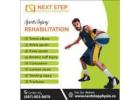Choose "Make this ad premium" at checkout.
300.00 Dollar US$ 5 MVA Injuries Treated with Physiotherapy Edmonton
- Location: Edmonton, Edmonton, Alberta, Canada
Motor Vehicle Accidents (MVAs) can result in a wide range of injuries, some of which may not be immediately obvious. Whether it’s whiplash from a rear-end collision or a more severe injury to the muscles and joints, physiotherapy plays a crucial role in the recovery process. At Next Step Physiotherapy , we specialize in treating Motor Vehicle Accident Physiotherapy Edmonton with a personalized approach designed to restore mobility, reduce pain, and improve quality of life. In this article, we will explore five common MVA injuries and how physiotherapy can help treat them.
Whiplash Injuries
Whiplash is one of the most common injuries sustained in rear-end car collisions. It occurs when the neck is suddenly and forcefully jerked forward and backward, causing strain on the muscles, ligaments, and tendons in the neck. Symptoms include neck pain, stiffness, headaches, dizziness, and difficulty moving the head.
How Physiotherapy Helps:
Physiotherapists use a combination of manual therapy, stretches, strengthening exercises, and modalities like heat and cold therapy to reduce pain and inflammation. The goal is to restore the normal range of motion in the neck and improve muscle strength to prevent future injuries.
Back and Spinal Injuries
Back and spinal injuries, including sprains, strains, and herniated discs, are common in MVAs. These injuries can result in severe pain, restricted mobility, and sometimes nerve damage that radiates down the arms or legs.
How Physiotherapy Helps:
Physiotherapists can help by assessing the extent of the injury and creating a rehabilitation plan that includes strengthening exercises, posture correction, and manual therapy techniques such as joint mobilizations and myofascial release. Core strengthening exercises are also crucial for stabilizing the spine and reducing the risk of further injury.
Shoulder Injuries
Shoulder injuries, such as rotator cuff strains, dislocations, or sprains, are common after a car accident, especially when the arms are braced during impact or if the shoulder takes the brunt of the collision.
How Physiotherapy Helps:
Physiotherapists use specialized exercises to strengthen the shoulder muscles and restore mobility. Manual therapy techniques like joint mobilizations and soft tissue massage may be used to alleviate pain and reduce stiffness. The goal is to improve the shoulder’s function and range of motion while preventing further damage.
Knee Injuries
The knees are vulnerable to injury in car accidents, especially when the knees hit the dashboard or are subjected to excessive pressure during the impact. Common knee injuries include ligament sprains, cartilage damage, and patella injuries.
How Physiotherapy Helps:
For knee injuries, physiotherapists design rehabilitation programs that focus on restoring knee stability, strength, and range of motion. Exercises may include strengthening the quadriceps, hamstrings, and calf muscles to support the knee joint. Manual therapy and modalities such as ultrasound therapy may also be used to reduce inflammation and promote healing.
Soft Tissue Injuries
Soft tissue injuries, such as muscle strains, ligament sprains, and contusions, are common after an MVA. These injuries may not always be immediately noticeable but can result in chronic pain, stiffness, and limited movement.
How Physiotherapy Helps:
Physiotherapists use a combination of treatments, including soft tissue mobilization, dry needling, and stretching exercises, to address soft tissue injuries. Strengthening exercises are also important to prevent future injuries and improve overall muscle function. Modalities like heat, cold therapy, and electrical stimulation may be used to reduce pain and inflammation.
Conclusion
Recovering from an MVA requires a comprehensive approach, and physiotherapy is a key part of that process. Whether you are dealing with whiplash, back pain, shoulder injuries, knee pain, or soft tissue damage, physiotherapists at Next Step Physiotherapy in Edmonton are dedicated to creating individualized treatment plans to help you recover faster, reduce pain, and regain full mobility. If you’ve been involved in an MVA, don’t wait to seek treatment.
#motorvehicleaccidentphysiotherapyedmonton #motorvehicleaccidentphysiotherapy #motorvehicleaccident #caraccidentedmonton #physiotherapynearme #physiotherapyedmoton #physicaltherapyedmonton #physicaltherapynearme #physicaltherapy #nextstepphysiotherapyedmonton #motorvehicleaccidentphysiotherapynearme #physicaltherapist #physiotherapyclinic #physioclinicedmonton






Useful information
- Avoid scams by acting locally or paying with PayPal
- Never pay with Western Union, Moneygram or other anonymous payment services
- Don't buy or sell outside of your country. Don't accept cashier cheques from outside your country
- This site is never involved in any transaction, and does not handle payments, shipping, guarantee transactions, provide escrow services, or offer "buyer protection" or "seller certification"
Related listings
-
 Key Components of a Successful Sports Rehabilitation ProgramHealth - Edmonton (Alberta) - December 26, 2024 Check with seller
Key Components of a Successful Sports Rehabilitation ProgramHealth - Edmonton (Alberta) - December 26, 2024 Check with sellerFor athletes recovering from injury, a well-structured sports rehabilitation program is essential for full recovery and return to play. A successful program focuses on multiple key elements that ensure comprehensive healing and a smooth transition ba...
-
 The Role of Dry Needling in Reducing Muscle TensionHealth - Edmonton (Alberta) - December 26, 2024 Check with seller
The Role of Dry Needling in Reducing Muscle TensionHealth - Edmonton (Alberta) - December 26, 2024 Check with sellerDry needling is an effective technique for reducing muscle tension, improving mobility, and alleviating chronic pain. It involves inserting thin needles into specific trigger points to release tight muscles. This treatment is gaining popularity in Ph...
-
 How Sports Physiotherapy Helps with Hip Labral TearsHealth - Grande Prairie (Alberta) - December 24, 2024 300.00 Dollar US$
How Sports Physiotherapy Helps with Hip Labral TearsHealth - Grande Prairie (Alberta) - December 24, 2024 300.00 Dollar US$A hip labral tear is a common injury, especially among athletes and active individuals. The labrum is a ring of cartilage that surrounds the hip socket, helping to stabilize the joint and maintain smooth movement. When this cartilage is torn, it can ...


